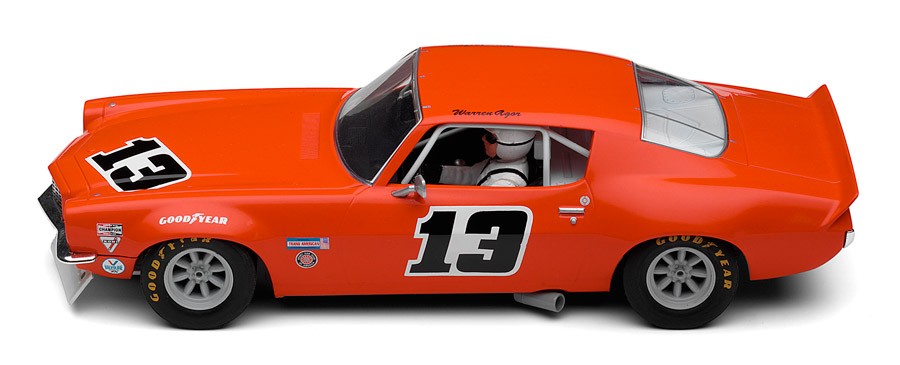Vonsirius-Slothead Trans Am Challenge
Vonsirius' solo racing series has been so well received, there just had to be a spinoff - the Trans Am Challenge.
This series will be unique because all cars will compete in the same race. How? Due to the magic of technology. I'm now a solo racer and also a programming nerd. This combination resulted in a program that reads in a description of a track, a list of cars, a list of lap times. The track is Shelby-Hendrix Speedway (SHS), a routed MDF track with a lot of turns and elevation changes. It has passing (4 inch lane spacing) and no-passing (2 inch lane spacing) sections. I designed it that way to make passing difficult as occurs in road racing. There are 7 sections in all - 1) start straight, 2) corner two, 3) corner three, 4) hairpin turn, 5) back straight, 6) loop turn, and 7) finish straight. Sections 2,4, and 6 are no-passing areas - cars have to exit those sections in the same order they enter. A faster car can catch a slower car in a no-passing section, but can't pass them.
At the start of a race the program reads the Racedata file which tells it what cars are in the race and sets the starting grid. In computer memory its as though the cars are starting single file, each a few tenths of a second behind the car in front of it. The lead car starts the race at time 0.00 by entering the 1st section. Shortly there after, at say time 0.25, the second car enters the first section and so on. Each car's lap time is divided up between the sections based on each section's length. At SHS section 1 is 12% of a lap, so if the lap time were 100 seconds it would exit section 1 after 12 seconds. If another car had a significantly faster lap time it's section 1 time might be fast enough to exit section 1 before cars that were ahead of it, meaning it passed them. However, since section 2 is a no-passing section the best a faster car can do there is catch a slower car and follow it till they get into section 3 where it might be able to make a pass. As the race timer moves forward the program keeps track of where each car is on the track and what the current running order is. The program displays what section each car is in as the race progresses and updates the leader board each time a lap is completed. All the data is saved to a log file so I can go back and see all the details afterwards.
From the program's perspective SHS is 1.56 miles long, and to make lap times realistic for a road course of that length I multiply the raw time (around 10 seconds) by 2.5 and add 42. This way a 10 second raw time becomes 67 seconds (83.82 mph). Because of the no-passing sections a faster lap time does not always mean making a pass during a lap, it depends on where a faster car catches a slower one. The first car out of a no-passing section gets to accelerate first and enters the next section with a slight lead that trailing cars would need to overcome. Trailing cars would also have to complete a pass before entering the next no-passing zone or be forced to 'fall back in line' and try again in another passing section. This keeps it interesting as it can take a faster car several laps to complete a pass.
Lastly, when recording lap times I keep track of any deslots and a penalty is assessed for each one. The length of the penalty is determined by where on the track a car deslots and how serious the spin or crash was. For a minor deslot where the car remains on the track right next to the slot the penalty is 4 - 6 seconds, just like when a 1:1 race car gets loose and has to get out of the gas. If the car leaves the track or hits a retaining wall the penalty is longer, around 12 seconds (though it could be as much as 99 seconds). A simple deslot would make a 67 second lap into a 71 second lap, with the extra time spent in the section where the incident took place. A section time of 12 seconds would become 16 seconds, and even if it's a no-passing section cars with a penalty can be passed (they are considered to be running out of the groove).
If I get 12 teams to sign up I'll be running 12 car races of around 40 laps each. The series will be 7 races long to see how it goes and the starting order will be set by series points with last place starting on the pole and the point leader starting last. This way every team has a chance and the ultimate winner will be the car/team with the most consistent performance.
Questions?
Slothead
This series will be unique because all cars will compete in the same race. How? Due to the magic of technology. I'm now a solo racer and also a programming nerd. This combination resulted in a program that reads in a description of a track, a list of cars, a list of lap times. The track is Shelby-Hendrix Speedway (SHS), a routed MDF track with a lot of turns and elevation changes. It has passing (4 inch lane spacing) and no-passing (2 inch lane spacing) sections. I designed it that way to make passing difficult as occurs in road racing. There are 7 sections in all - 1) start straight, 2) corner two, 3) corner three, 4) hairpin turn, 5) back straight, 6) loop turn, and 7) finish straight. Sections 2,4, and 6 are no-passing areas - cars have to exit those sections in the same order they enter. A faster car can catch a slower car in a no-passing section, but can't pass them.
At the start of a race the program reads the Racedata file which tells it what cars are in the race and sets the starting grid. In computer memory its as though the cars are starting single file, each a few tenths of a second behind the car in front of it. The lead car starts the race at time 0.00 by entering the 1st section. Shortly there after, at say time 0.25, the second car enters the first section and so on. Each car's lap time is divided up between the sections based on each section's length. At SHS section 1 is 12% of a lap, so if the lap time were 100 seconds it would exit section 1 after 12 seconds. If another car had a significantly faster lap time it's section 1 time might be fast enough to exit section 1 before cars that were ahead of it, meaning it passed them. However, since section 2 is a no-passing section the best a faster car can do there is catch a slower car and follow it till they get into section 3 where it might be able to make a pass. As the race timer moves forward the program keeps track of where each car is on the track and what the current running order is. The program displays what section each car is in as the race progresses and updates the leader board each time a lap is completed. All the data is saved to a log file so I can go back and see all the details afterwards.
From the program's perspective SHS is 1.56 miles long, and to make lap times realistic for a road course of that length I multiply the raw time (around 10 seconds) by 2.5 and add 42. This way a 10 second raw time becomes 67 seconds (83.82 mph). Because of the no-passing sections a faster lap time does not always mean making a pass during a lap, it depends on where a faster car catches a slower one. The first car out of a no-passing section gets to accelerate first and enters the next section with a slight lead that trailing cars would need to overcome. Trailing cars would also have to complete a pass before entering the next no-passing zone or be forced to 'fall back in line' and try again in another passing section. This keeps it interesting as it can take a faster car several laps to complete a pass.
Lastly, when recording lap times I keep track of any deslots and a penalty is assessed for each one. The length of the penalty is determined by where on the track a car deslots and how serious the spin or crash was. For a minor deslot where the car remains on the track right next to the slot the penalty is 4 - 6 seconds, just like when a 1:1 race car gets loose and has to get out of the gas. If the car leaves the track or hits a retaining wall the penalty is longer, around 12 seconds (though it could be as much as 99 seconds). A simple deslot would make a 67 second lap into a 71 second lap, with the extra time spent in the section where the incident took place. A section time of 12 seconds would become 16 seconds, and even if it's a no-passing section cars with a penalty can be passed (they are considered to be running out of the groove).
If I get 12 teams to sign up I'll be running 12 car races of around 40 laps each. The series will be 7 races long to see how it goes and the starting order will be set by series points with last place starting on the pole and the point leader starting last. This way every team has a chance and the ultimate winner will be the car/team with the most consistent performance.
Questions?
Slothead









